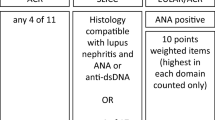Abstract
The chikungunya virus (ChikV) is a reemerging mosquito-borne pathogen that causes disabling chronic arthritis. The relationship between clinical evolution and inflammatory biomarkers in patients with ChikV-induced arthritis has not been fully described. We performed a prospective case series to evaluate the association among joint involvement, self-reported disability, and inflammatory biomarkers. Patients with ChikV infection were followed for 1 year. Joint involvement and self-reported disability were evaluated with disease activity index 28 (DAS-28) and World Health Organization Disablement Assessment Schedule II (WHODAS-II). Interleukin-6 (IL-6), C-reactive protein (CRP), erythrocyte sedimentation rate (ESR), and rheumatoid factor (RF) were used as biomarkers. Ten patients with mean age 48 ±15.04 years were included. Symptoms at diagnosis were fever, arthralgias, myalgias, rash, arthritis, nausea, vomiting, and back pain. Polyarticular involvement was present in seven cases. At diagnosis, measures were as follows: DAS-28, 5.08±1.11; WHODAS-II score, 72.3±10.3 %; CRP, 5.09±7.23 mg/dL; ESR, 33.5±17.5 mm/h; RF, 64±21.7 IU/mL; and IL-6, 17.6±10.3 pg/mL. Six patients developed subacute and chronic symptoms. During follow-up, DAS-28 index, WHODAS-II score, ESR, and IL-6 were statistically different in patients with subacute and chronic symptoms compared to those who resolved in the acute phase (p < 0.05). DAS-28 index, WHODAS-II score, and IL-6 were related to chronicity of articular symptoms and could be used as predictors of ChikV-induced arthritis.
Similar content being viewed by others
References
Schwartz O, Albert ML (2010) Biology and pathogenesis of chikungunya virus. Nature. Rev Microbiol 8:491–500
Weaver SC, Lecuit M (2015) Chikungunya virus and the global spread of a mosquito-borne disease. N Engl J Med 37:1231–1239
Kautz TF, Díaz-González EE, Erasmus JH et al (2015) Chikungunya virus as cause of febrile illness outbreak, Chiapas, Mexico, 2014. Emerg Infect Dis 21(11):2070–2073. doi:10.3201/eid2111.150546
Organizacion Panamericana de la Salud (2011). Preparación y respuesta ante la eventual introducción del virus Chikungunya en las Américas. Recovered of http://www1.paho.org/hq/dmdocuments/CHIKV_Spanish.pdf .
Manimunda SP, Vijayachari P, Uppoor R et al (2010) Clinical progression of chikungunya fever during acute and chronic arthritic stages and the changes in joint morphology as revealed by imaging. Trans R Soc Trop Med Hyg 104:392–399
Chen W, Foo SS, Sims NA et al (2015) Arthritogenic alphaviruses: new insights into arthritis and bone pathology. Trends Microbiol 23:35–43
Chow A, Zhisheng H, Ong E et al (2011) Persistent arthralgia induced by chikungunya virus infection is associated with interleukin-6 and granulocyte macrophage colony-stimulating factor. J Infect Dis 203:149–157
Lohachanakul J, Weerawat P, Thannagith M et al (2012) High concentrations of circulating interleukin 6 and monocyte chemotactic protein-1 with low concentrations of interleukin-8 were associated with severe chikungunya fever during the 2009-2010 outbreak in Thailand. Microbiol Immunol 56:134–138
Garin O, Ayuso-Mateos JL, Almansa J et al (2010) Validation of the “World Health Organization Disability Assessment Schedule, WHODAS-2” in patients with chronic diseases. Health Qual Life Outcomes 8:51. doi:10.1186/1477-7525-8-51
Singh JA, Saag KG, Jr SLB et al (2015) American College of Rheumatology guideline for the treatment of rheumatoid arthritis. Arthritis Care& Research. doi:10.1002/acr.22783
Chopra A, Anuradha V, Ghorpade R et al (2012) Acute chikungunya (CHIKV) and persistent musculoskeletal pain following the 2006 Indian epidemic: a two year prospective rural community study. Epidemiol Infect 140:842–850
Rahim AA, Thekkekara RJ, Bina T, Paul BJ (2016) Disability with persistent pain following an epidemic of chikungunya in rural South India. J Rheumatol 43:440–444
Arroyo-Ávila M, Vilá LM (2015) Rheumatic manifestations in patients with chikungunya infection. P R Health Sci J 34:71–77
Rodríguez-Morales AJ, Cardona-Ospina JA, Urbano-Garzón SF, Hurtado-Zapata JS (2016) Prevalence of post-chikungunya chronic inflammatory rheumatism: a systematic review and meta-analysis. Arthritis Care Res (Hoboken). doi:10.1002/acr.22900 Mar 25, [Epub ahead of print]
Hawman DW, Stoermer KA, Montgomery SA et al (2013) Chronic joint disease caused by persistent chikungunya virus infection is controlled by the adaptive immune response. J Virol 87:13878–13888
Venugopalan A, Ghorpade RP, Chopra A (2014) Cytokines in acute chikungunya. PLoS One 9:e111305
Chow A, Her Z, Ong EK et al (2011) Persistent arthralgia induced by chikungunya virus infection is associated with interleukin-6 and granulocyte macrophage colony-stimulating factor. J Infect Dis 203:149–157
Author information
Authors and Affiliations
Corresponding author
Ethics declarations
Disclosures
None.
Rights and permissions
About this article
Cite this article
Sepúlveda-Delgado, J., Vera-Lastra, O.L., Trujillo-Murillo, K. et al. Inflammatory biomarkers, disease activity index, and self-reported disability may be predictors of chronic arthritis after chikungunya infection: brief report. Clin Rheumatol 36, 695–699 (2017). https://doi.org/10.1007/s10067-016-3419-2
Received:
Revised:
Accepted:
Published:
Issue Date:
DOI: https://doi.org/10.1007/s10067-016-3419-2




